March 24, 2025
He is a podcast I did with Maggie Kelly on her Life Illuminated Podcast
https://podcasts.apple.com/us/podcast/exploring-the-tarot/id1386597844?i=1000699726265
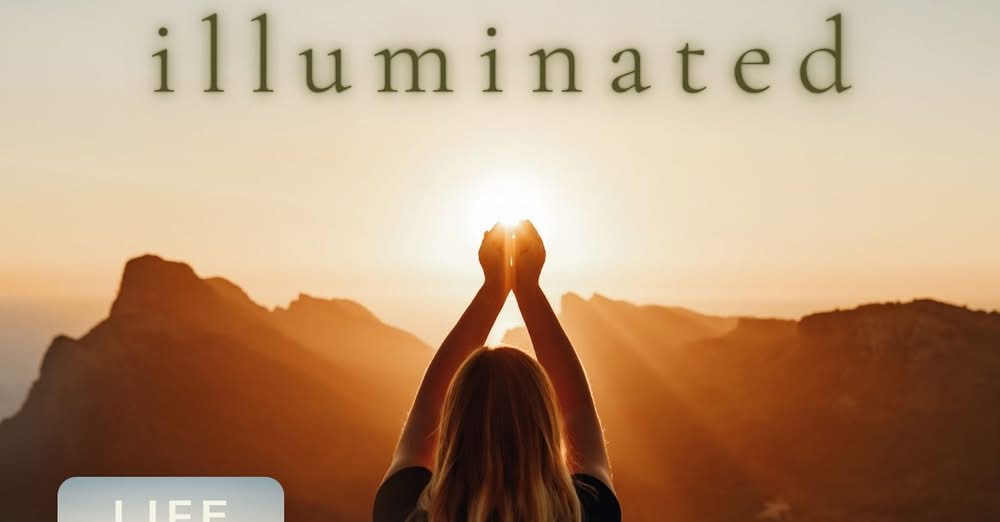
November 24, 2024
Here’s a new podcast that I did with Sabrina and Tales of Resistance
https://www.youtube.com/watch?v=Di9qqQWqU8c
August 27, 2024
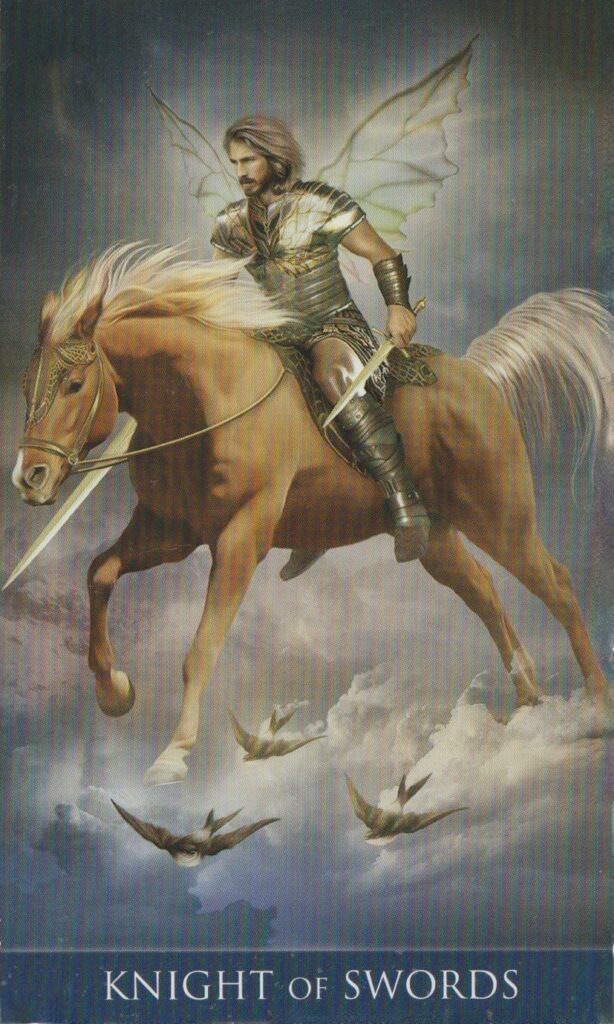
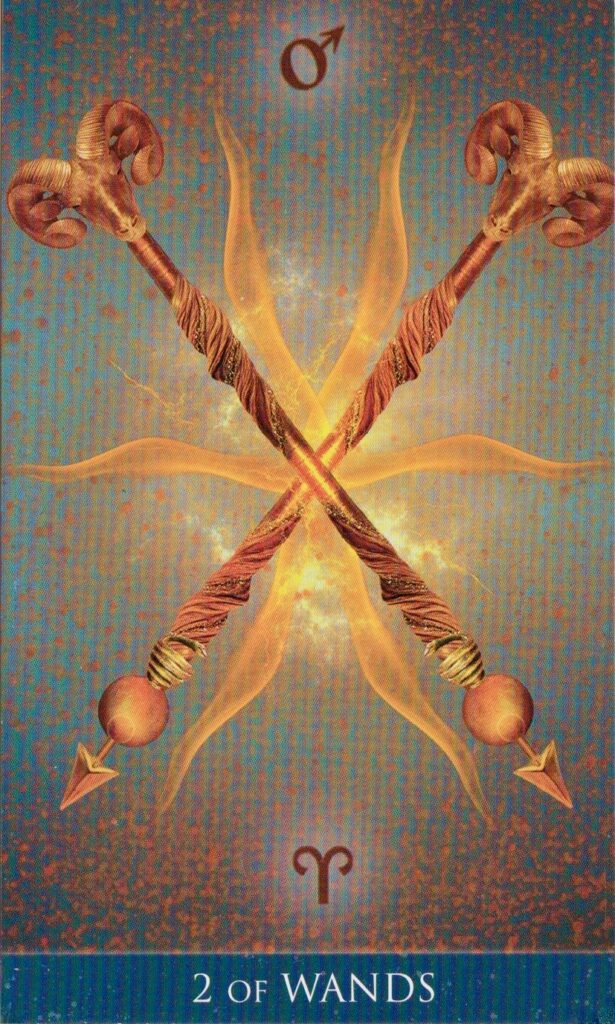
The Knight of Swords and the 2 of Wands is a powerful combination of cards. The 2 of Wands is about having confidence. Confidence is both a positive feeling and a frame of mind. When thoughts and feelings combine in this way, our bodies typically glow with energy and wellness. This is part of the reason why confidence is so attractive (as well as sensual). The Knight of Swords is about engaging in challenges, defending yourself and others, moving forward and successfully in life. When drawn together, you will be moving forward rapidly in your life and this will involve all those related stresses, fears, and frustrations that occur with increased speed and less leisure time. Nevertheless, you will be successful and will enjoy the ride! Bring it on! And lastly, remember that you can only operate at this high level for a time.
August 25, 2024
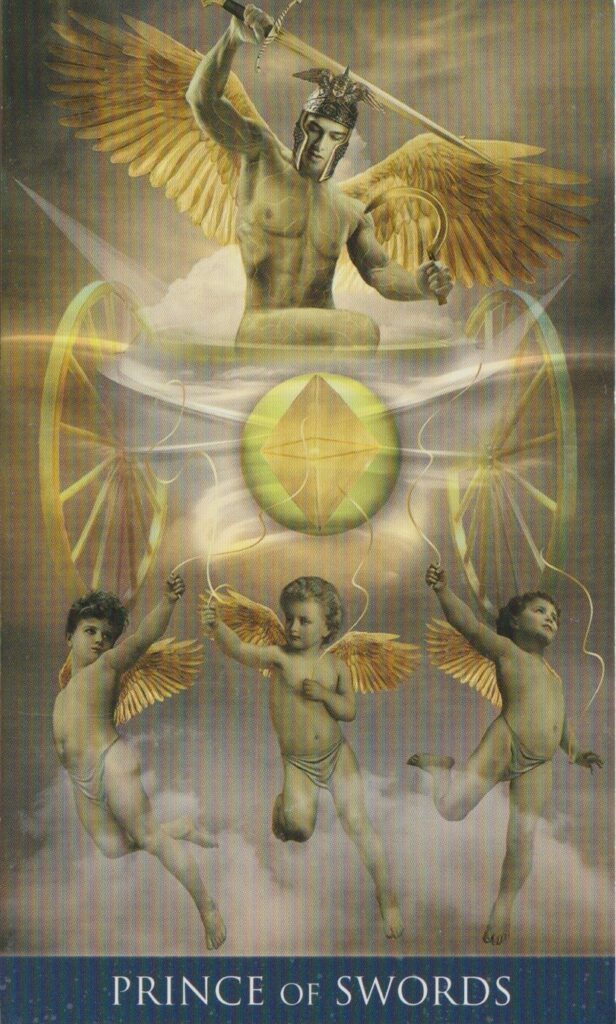
Sometimes, it’s good to hold back from starting something new. Other times, we need to be bold, confident, assertive, and celebratory. As Goethe says, “Boldness has a genius and magic in it.” Be grateful, cheerful, and full to the brim with hope, ability, action, and confidence. Bring something new into this world. Go for it!
August 20, 2024
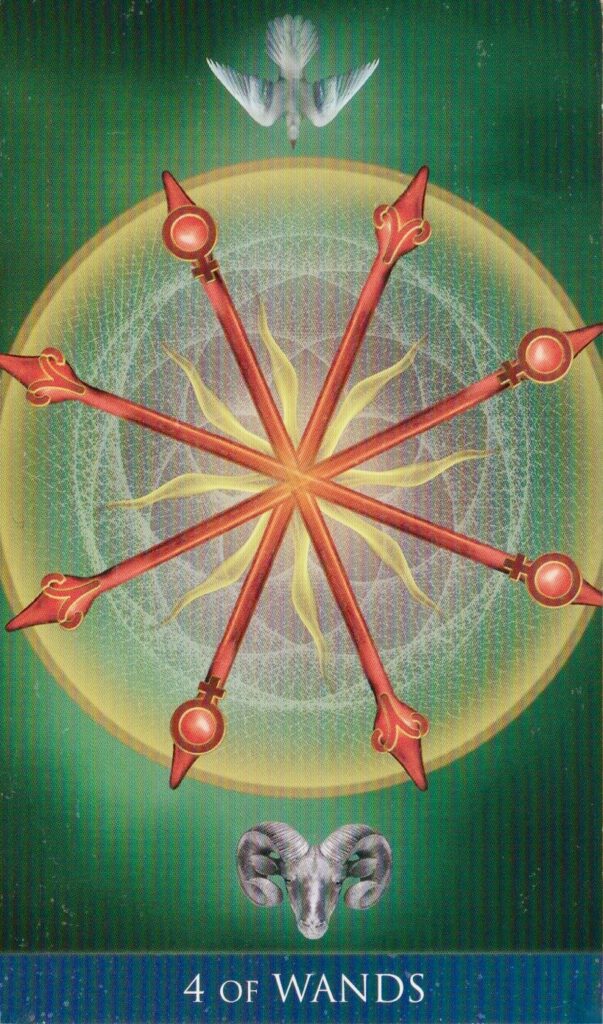
The Four of Wands reminds us how important our friends, colleagues, team members, etc. are to our journey forward. There are times when we must travel alone. And there are other times when we shouldn’t–this is one of those times. Further, this card shows the power of diversity in the group dynamics of our team. We see the opposites of Venus and Ares creating a circle that is ready to roll forward in an exiting mix.
August 19, 2024
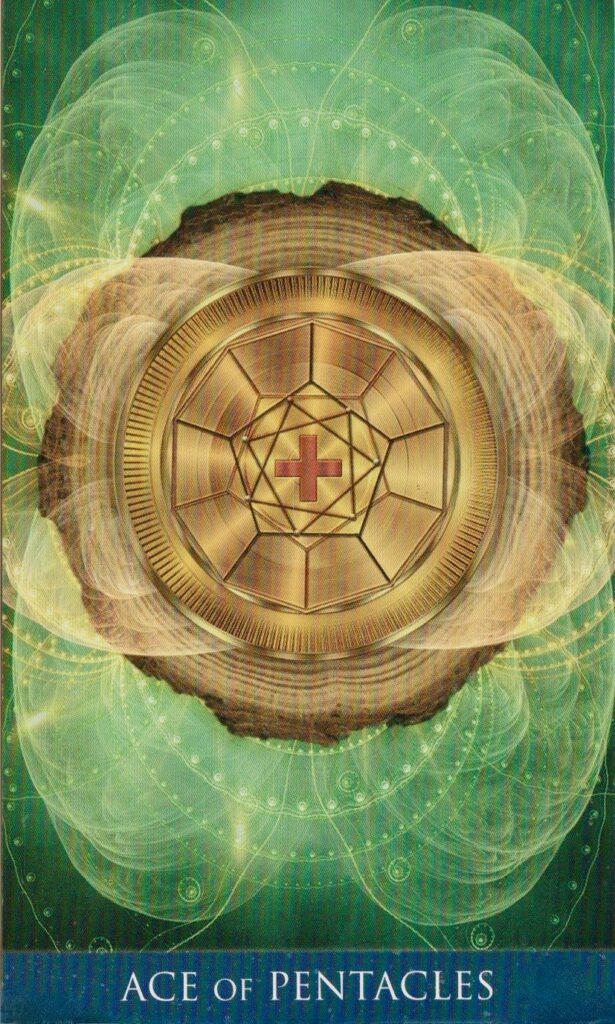
The Ace of Pentacles is all about starting something new: a project, a job, school, social group, etc.! But not everything that we begin doing will be turn out well for us. This card, however, is reassuring us that whatever it is that we are starting to do at this time will turn out good for our identity, our pocketbook, and our journey forward.
April 5, 2024
Sign up for The Galaxy News Letter!
November 21, 2023
Join my free email subscription service: The Universe-Psychic Galaxy: an occasional publication all about all things metaphysical and magical and stay in touch with all the latest posts and updates.

November 5, 2023
I have published a new welcome video to my site: The Universe-Psychic. Click below to view
New Tarot Poetry
https://universe-psychic.com/wp-content/uploads/2023/06/The-High-Priestess.pdf
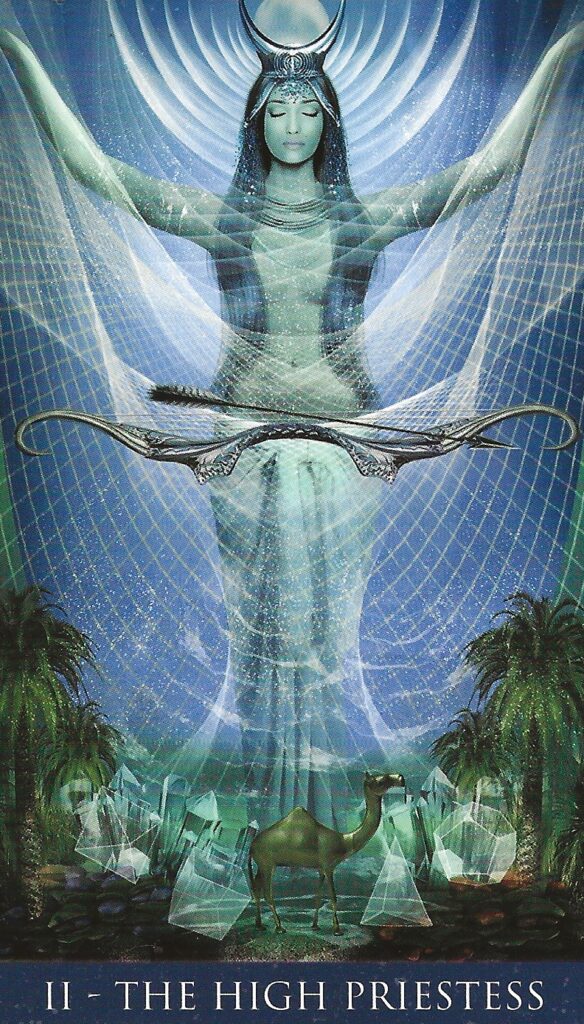
April 7, 2023
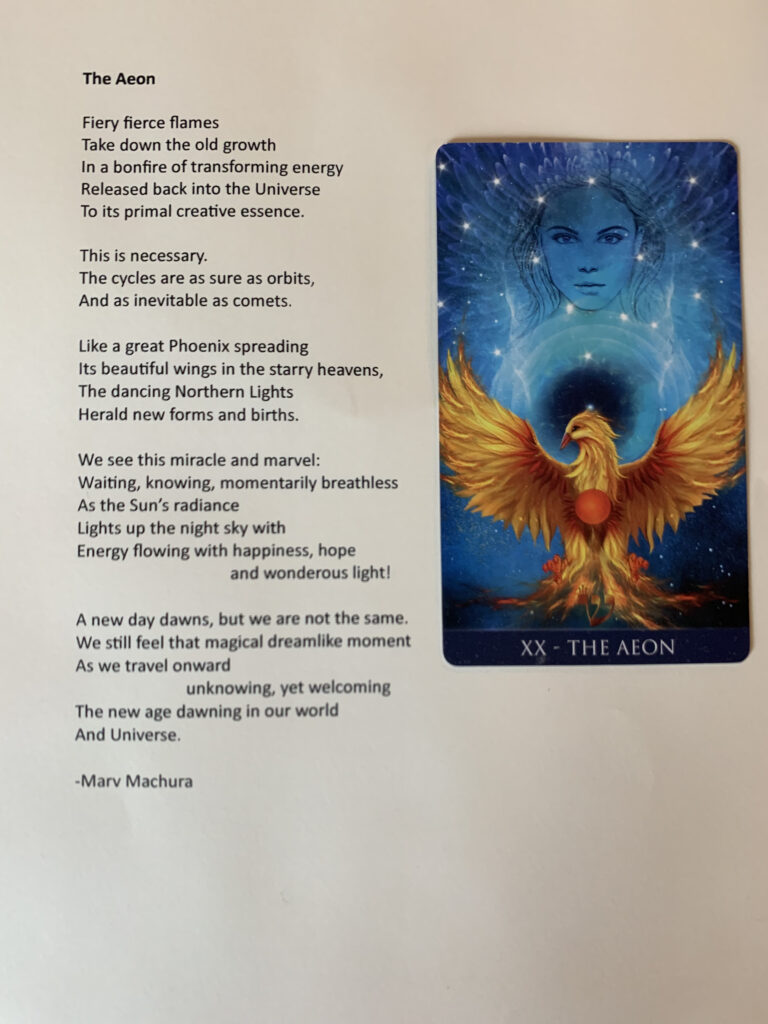
January 31, 2023
The Prince of Pentacles
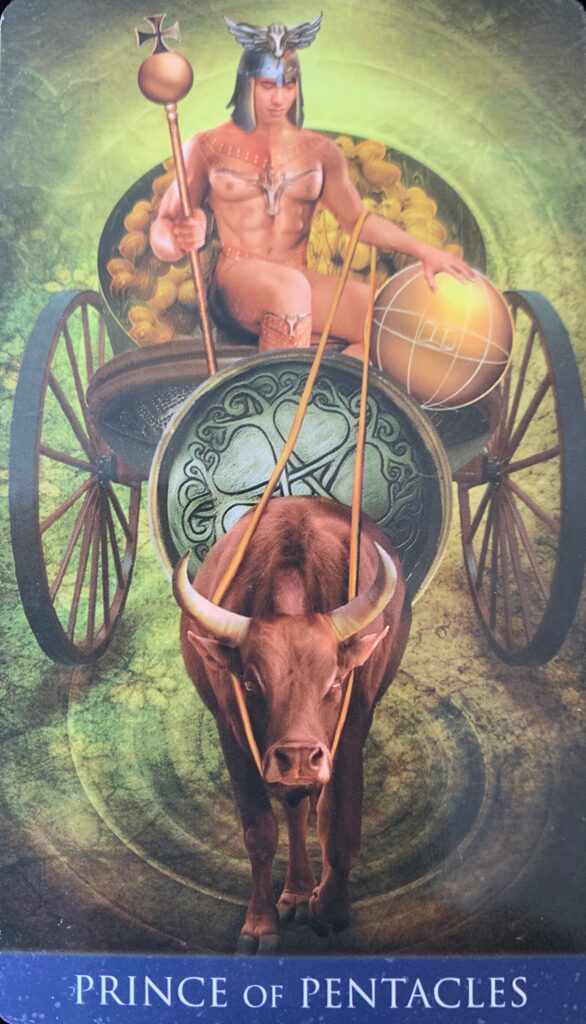
The Prince of Pentacles
Marv Machura
The Prince of Pentacles
The first thing that gets our attention, aside from the stunningly beautiful Prince of Pentacles himself, is the gentle green colours of the background, figure (shield), and foreground in this card. Green is an ambiguous colour in this presentation. Yes, it is good and green, but it is also shadowy and dark. There are great things here in abundance, but they are not given to us for free or without temptation for us to go astray with all these blessings.
As we look at this card, as if we are standing in front of the prince and his ox‑pulled wagon, we feel a personal trial or challenge upon us. Our first meeting with the Prince of Pentacles is somewhat confrontational, but not in an unnatural or bad way.
The same is true if we put ourselves in the position of the prince, himself. We feel the same misgivings fixed against the overall goodness of the situation. This is like when entering a new land or situation as a stranger with our immense potential by our side. We can see this great potential illustrated by the full cart that travels with the prince and in other aspects of the card. We hear the undercurrents say, “Go on, prove yourself. You are welcome here, but…”
The glowing green background sets us in a place of newness and plenty. The welcoming green circular carpet in the foreground is replete with impressions of safety, home, and comfort. The pentagram‑inscribed green shield of the chariot wagon gives us pause as well as restrained peace. At times like this during a planned transformation of entering a new land literally or metaphorically with all our accoutrements, skills, material wealth (and potential), we are compelled to feel excitement mixed with measured anxiety as illustrated in this card.
The Prince of Pentacles sits in a chariot full of fruits and seeds. These fruits and seeds are symbolic of growth and opportunity. Nevertheless, over‑indulgence and temptation lurk in this abundance. Thus, we need to be especially careful to avoid these temptations as we travel onward.
As a tree is known by its fruit, so are we known by our works. This principle fills this card with provocative meanings. It is time to embrace engagement and productivity but also time to be careful that our works are good and not evil. Noxious fruits will grow out of excessive pride, greed, and arrogance. Wholesome fruits will grow out of self‑control, kindness, gentleness, love, and joy.
The posture of the prince is firm and strong, yet he is looking downward in a show of humility and thankfulness. This modesty and gratitude assure us of goodness of spirit. This promise of goodness is also reflected in the golden colours of the fruits, seeds, and background glow that emanates from the cart.
The seeds, specifically, in the chariot represent potential, embryonic power, and life to be. These seeds combine with other visual elements in the card such as the wheels on the chariot and the moving-forward aspect of figure and ground to create a strong sense of both conceivable and achievable objectives that can and will blossom with time, consistent effort, and continued determination.
The fact that the prince is seated in a chariot represents his power to overcome obstacles with resolve, courage, focus, and willpower. It also reinforces important aspects of forward material progress such as ambition, motivation, control with a desirable balance between our heart and our mind.
The prince’s strong, nude body represents fertility and fecundity. This nude representation helps to show us that this prince is in the youthful prime of his manhood with its glory and potential on display; yet importantly, the prince’s body language is modest showing us that the Prince of Pentacles is only dimly aware of his own condition and potential greatness. This unawareness and innocence are strong bulwarks against all the negative effects that can flow from pomposity, arrogance, and conceit. These negative tendencies springing from self‑aggrandizement can be particularly tragic when manifested in the mind and body of a young person.
Bull and ox imagery in this card is readily apparent and can be seen in the ox pulling the chariot, two bull tattoos on the prince (chest and left leg), and the winged bull on the helm of the prince’s helmet. The bull represents wealth and abundance. It also represents strength, power, ferocity, stubbornness, and tyranny. The ox represents slow and steady progress. Thus, this card reminds us of the potent mixture formed by combining sheer epic strength (the bull) with resolute determination (the ox). Little can stand in the way of the forward progress of those who possess and practice these characteristics.
The bull imagery in the Prince of Pentacles also connects this card to the zodiac constellation of Taurus. Taurus makes the connection with things of a material nature and of the earth which is appropriate for the suit of Pentacles. The Taurus traits of love, friendship, luxury, and money all flow from this card’s imagery, as do traits of dependability, loyalty, and pride in one’s home and family. These aspects of comfort, beauty, and homelife are represented well by the circular pattern on the Persian carpet on which the prince appears to travel and is grounded.
The prince holds a scepter with a sphere surmounted by an iron cross in his right hand. This globus crucifer (cross-bearing orb) is a symbol of authority in the Christ-like sense of authority to serve and sacrifice for the benefit of others. Not all globus crucifers feature an iron cross. The iron cross is a symbol of the highest bravery and courage, especially in defence of home and country which adds to the Prince of Pentacles many fine and extraordinary qualities.
In his left hand the prince holds a large golden sphere with a smaller square in its center as well as finely‑drawn longitudinal and equatorial lines. This represents the steady passage of time. This sphere reflects how the earth turns and we experience days that eventually turn into seasons which in turn slowly and steadily become years. However, the inevitable passage of time and change is balanced with the cube inscribed in the center of this sphere showing how stability and permanence are maintained despite this spinning earth on which we live.
The ornate carvings on the chariot and large Celtic floral design on the disk separating the ox from the chariot all confirm and reflect the love of things natural and beautiful such as flowers and art. Again, with the relationship to Taurus and its idiosyncrasies, these things are especially valued when used to enhance any home or means of travel as suggested in this card’s imagery.
So in conclusion, this card encourages us to move forward with strength, humility, gratitude, and energy. Be assured that we will be fortified by all those forces and elements described herein.
The Universe has filled our present with an auspicious and blessed beginning. Take it easy; go forward; enjoy. All should be well. Stay humble. Focus on the big picture and be grateful. Life is going to be not only better, but also much more interesting. Roll on.
Marv Machura
November 15, 2022
The Queen of Wands
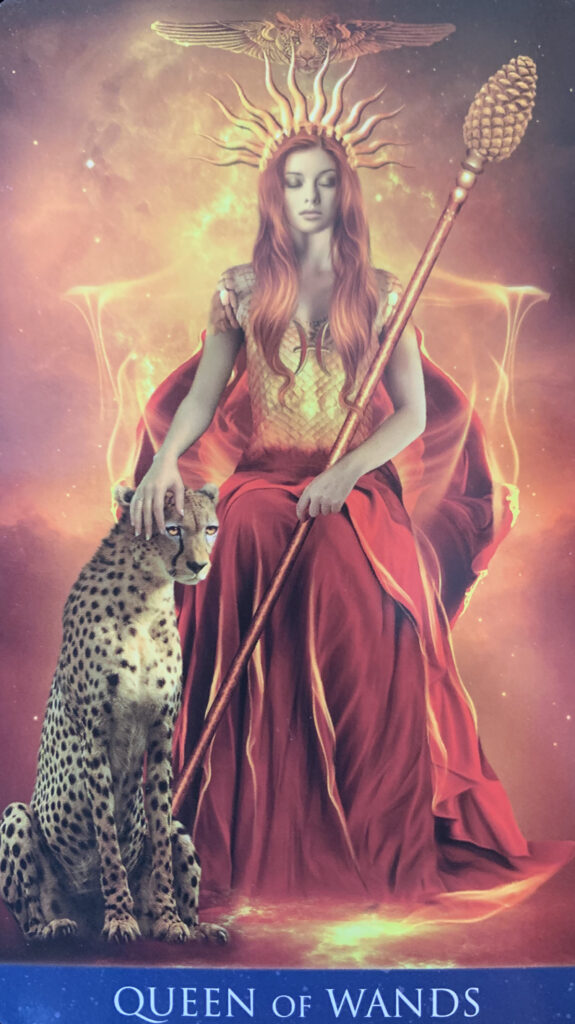
The Queen of Wands
Marv Machura
The Queen of Wands is pictured as a noble, powerful, calm, and mighty queen. Although she is seated and seemingly at rest, peace, and ease, there are other elements that remind us that she is holding much in reserve. Her authority and command have much clout and inherent danger and risk for those who would chance her ire through any means, but especially through disrespect or disregard.
The Queen of Wands has the command to destroy and eradicate a person with just a look. In North American First Nations’ cultures, the leopard is known by a name that translates into “she who kills with one blow.” And this is one of the relationships we can see presented here between the Queen and the leopard sitting by her right side.
But, it is not the time or place to strike and kill; it is time for reflection and rest. And importantly, it is not the time to be putting our energy into useless, frivolous, and trifling things. We need to stay calm, reserved, and ready to reap all the good things that such a wonderful, strong, and non-neurotic queen deserves—because these good things are coming our way.
This card reminds us that there is a cargo of extra energy under the calm surface that may be needlessly and carelessly spent and split, causing harm not only to ourselves but also to those who serve us and those who depend on us. Stay noble. Avoid all neurotic actions and worries.
In short, trust the Universe and the big picture of our life. We have done well, and a deserved rest is both coming and needed. It is not a time for fear, worries, and apprehension. This is also represented by the great leopard that is sitting calmly on the Queen’s right side. Leopards are spiritually by our side as our life path unfolds with strength and confidence. They are also a great aid to our powers of intuition and intention. Cultures across the globe use and revere leopards for these purposes. Also, it is tradition that a leopard comes to us after times of great suffering. The leopard helps us take back our power, get rid of negative behaviour, and embrace fresh new approaches and perspectives.
This Tarot card is rich with personal affirmations of all the beauty, power, graciousness, and potential in us—as individuals. This is further reflected and represented by the fact that leopards are solitary hunters. Keep in mind, nevertheless, that the leopard is not here to change us: a leopard cannot change its spots, after all. The leopard is here to remind us that our spots are what give us our individuality and related identity. And, having a clear sense of individuality and identity is huge source of energy and nobility.
There is a pronounced golden‑red colouring in this card. Gold is the colour of completion and spiritual attainment. Red is the colour of vibrancy, fire, and power. When these two colours are combined like they are with this card, it represents an authoritative state of divine perfection, completion, superiority, and strength.
We have not arrived at this place by accident. We have gotten here through difficult, exhausting, principled, and individual effort. We should be feeling good about ourselves and our achievements. We should take time to be gentle with ourselves and with others around us from this high place of reward, respite, and regeneration.
There are two great lionesses on this card. The most noticeable one is the great leopard on which the Queen of Wands rests her hand, gently stroking and comforting the great cat that we have hitherto referred. The other lioness is at the top center of the card in the form of a winged head. Both of these lionesses represent control, influence, and undisputed rule. As female lions, they represent the Great Mother and protective energies rather than aggressive and conquering drives and vanities that are more associated with male lions. This is not a time of battle and glory; it is a time of redress and restoration.
The winged lioness at the top of the card is representative of ancient Persian and other cultures who used similar images and stone reliefs to show the fierce female aspect of protection on their walls and palaces. Only with this type of protection, can our energies be restored, repaired, and enhanced as pictured in this card.
The Queen of Wands sits on a throne made of pure ethereal energy. She is also surrounded by this same energy that radiates outward from her seated figure. We see this energy as a positive force that is both comforting and empowering. It is a loving gift from the Universe. It is a great blessing and benediction. It is also indicative of a reciprocal relationship that is formed with the Universe at times like this. This is to say that by being gracious and grateful for these gifts and blessings, more gifts and blessings come to us.
Like a kind of holy communion, as in receiving the bread and wine in a Catholic Church Mass, it is only when we receive with reverence and gratitude, that the blessings are manifest and multiplied according to our needs, worth, and humility. The Queen of Wands on this card is very much an image of humility, grace, and gratitude surrounded by the loving energy of the Universe working in its reciprocal glory.
On the Queen of Wands’ head is a spectacular tall gold crown with 12 golden rays radiating outward in a stunning display of influence and power. However, these 12 rays are more than a splendid and arresting design for a impressive golden crown. The number 12 is connected to the concept of completeness and fullness in the Zodiac and other well-known manifestations such as the 12 Apostles. This complements the meanings of rest after completion described above. It also represents deep physical, spiritual satisfaction and actualization. This is the crux of “The Wisdom of the 12 Rays” and the spiritual accession that is implicit in these teachings.
The sign for Pisces is prominently a part of the Queen’s golden bodice. Pisces is the deep‑diver of all things physical and metaphysical. Pisces have to figure it out by themselves and thus, this symbol is reflecting the independent self and self-realization of the Queen of Wands.
The Queen’s knowing and content look is the end result of this Piscean tendency. This eloquent look can only come after much questioning, effort, and debate. Her situation is much like the time that we are currently going through: the end of the Age of Pisces and the beginning of the Age of Aquarius. The Piscean Age has been characterized by the desire to question everything and anything: manifested best in the Renaissance and Scientific Revolution but also in countless other movements and trends.
The Age of Aquarius that has begun will be also be represented by a similar kind of individuality, questioning, and self‑generated religiosity as in the Age of Pisces. This is in the Aquarian’s nature, after all. So, there will continue to be less centralized and mass movements of blind faith going forward. However, the often‑acerbic and violent nature of the Piscean will be replaced by the joyously open and accepting attitude of Aquarian.
The Aquarian is a brother and sister to all, and while this is not the main thing to get from this card in the Tarot, The Queen of Wands can be seen as personification of both The End of the Age of Pisces and the Dawn of the Age of Aquarius given these predilections that we note here.
Finally, we see to the great golden wand held in the Queen’s left hand and leaning across her lap and shoulder. It is topped with a huge fir or pine cone. This pine cone immediately connects us to the pineal gland of the Sumerians and countless other cultures who have long associated these cones to the metaphysical and to the giving and receiving of enlightenment. Appropriately, the Queen of Wands holds a great wand of this vital energy, fire, and metaphysical power.
It is true that few can withstand the transfer of this energy in its pure form, hence the role of the Magus, but for this card, all of us may expect this dazzling “seed” of energy, health, and vitality to take some root in our lives and for us to continue to mine this massive source of energy in our lives both physically and metaphysically, in equal proportions. After all, we are at our best when we are balanced in this manner. Long live the Queen!
August 14, 2022
The Prince of Cups
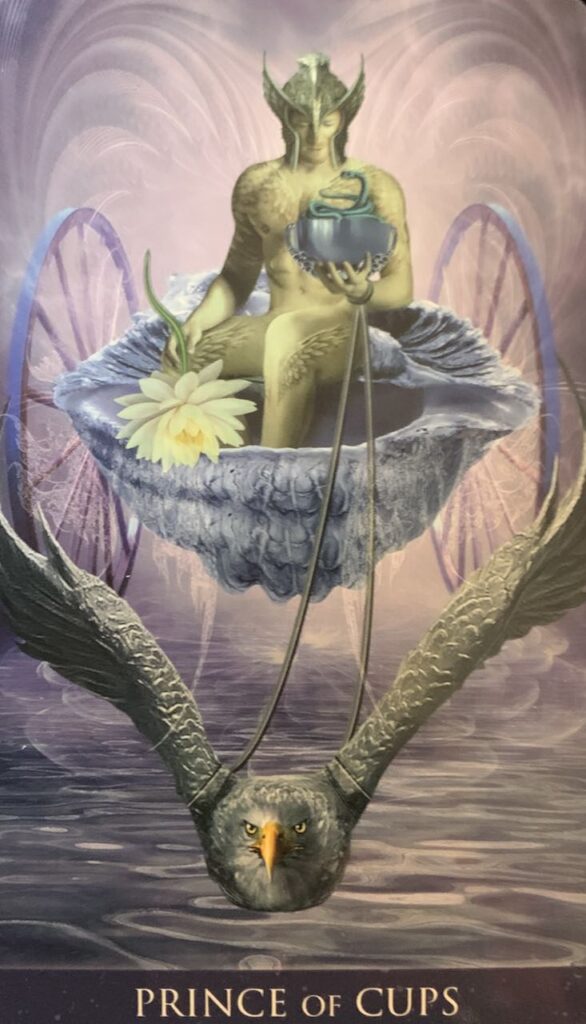
In The Millennium Thoth Tarot Created by Renata Lechner Published by Lo Scarbeo, Torino (c) 2017
– Marv Machura
The first thing we notice about this card, The Prince of Cups, is its sense of motion; the Prince, his seashell chariot, his powerful silver eagle are heading straight at the viewer in an unstoppable, dramatic, and confident manner. The noble Prince is looking downward in a humble, yet convincing, sense of both himself and his direction.
A swirling, purple dawn surrounds the Prince and his celestial chariot helping to create this scene of assured, cosmic, forward movement. Thus, the overall message of this card is clear: we are entering a new and wonderful day or age with strength, divine dignity, purpose, and assistance/encouragement from the Universe.
The potential of this new age is immense.
A purple and violet dawn is a somewhat rare occurrence. It is more common for morning skies at dawn to be mostly blue with some orange or red mixed into the wondrous scene, depending on the clouds and atmospheric conditions. Another more common dawn colouring is a deep fiery red that often precedes storms. Most of us are familiar with the saying, red in the morning, sailors take warning. This is because when atmospheric clouds are thickening into storms, this changes the light spectrum from blue to red. But, when atmospheric clouds are thinning as in after a storm, especially serious storms such as hurricanes, the morning light spectrum starts to go back towards blue, causing this purple phenomenon. Thus, a purple dawn tells us that the storms are ending and a beautiful day is beginning.
The purple dawn represents a new, promising, auspicious, and royal change about to happen, just as a purple dawn predicates a new and beautiful day. In both the card and the weather phenomenon, this colour appears after enduring a stormy period literally for the weather and metaphorically for the Prince. We can also note that these purple and violet hues are colours associated with royal identity and all that goes along with nobility, privilege, and power. These colours are also symbolic of wisdom, bravery, and spirituality. Purple and violet also trigger our sense of wonder, imagination, mystery, and magic. This card, thus, is representative of all of these good, gallant, new, and enchanting things.
The Prince sits in a small, single‑seat, violet chariot that is made from a large seashell. All humans are mystically drawn to and connected to seashells. Children show this innate tendency vividly when on a beach. We see how it is nearly impossible for any of us to not be drawn to seashells because they hold so much positive, healing, and elemental energy. When we see one, we instinctually pick it up, examine, and hold it. Typically, we also will want to keep the shell, usually without considering why.
It is not an accident that seashells are foundational in our conception of value, and why they were used as the first form of money in most human communities around the world. Seashells, like the one in which the Prince sits, give us balance, wealth, protection, energy, and health. They help connect us to life‑giving water as perhaps no other earthy element can or does. It is always good for us to have some seashells in our collections of mystical elements or adornments that assist our metaphysical vibrations. As mentioned, seashells are more than just representative; they are givers and producers of goodness and wellness for our emotional and physical lives.
This strong, nude Prince sits in this magical, purple shell that is giving‑off good energy that we can see swirling around and emanating from the shell‑chariot. On his nude body are tattoos of yellowish wings. His nudity is symbolic of his purity of spirit and purpose. He has nothing to hide. He is coming forward into a new life without shame and without any hidden baggage from his previous adventures. And this nudity shows that his strength is on display in a beautiful and natural manner that others will notice.
Not only is the Prince journeying forward without baggage or shame, he is journeying forward with distinction and decoration. The yellow wing tattoos covering parts of his body represent his earned honours, position, and skills. Granting wings, for example, in the military is an important ceremony that only comes after hard‑won accomplishments and victory.
In his right hand, the Prince holds a magnificent white lotus blossom. This large and beautiful white blossom stands out on this card with its size, freshness, and beauty. The Prince holds it by a seemingly living or writhing green stem. All of this reinforces the Prince of Cups purity of spirit and motivation acting in the present and living sense. It also reinforces the restraint of ego pride and id bestiality.
The Prince must beware of these things given his position, power, and strength. Excessive pride and sexual promiscuity are evils that are always near the surface for those so blessed as this Prince. Holding this important symbol in his right or dominant hand shows the importance of controlling these potential evils.
In his left hand, the Prince holds a large blue cup. Inside this cup there is a blue snake. We can see it writhe and stick out its head. The Prince is looking down at this cup and snake.
This blue snake has an ambiguous meaning, as is the case with most snakes. On the one hand, it is representative of knowledge and power over ignorance, but on the other hand it is symbolic of dangers, especially deceit and deception.
For this card, both meanings are possible. The Prince must be wary of trickery and duplicity awaiting him in his future. His nobility, strength, and beauty will inevitably draw people to him who will not have his best interests. These will be people who will seek to deceive him with flattery or other means for their own selfish gains and possibly ruin all the goodness inherent to this Prince’s forward progress and purpose. Thus, the Prince must be very careful as he travels onward. This watchfulness of his is clearly illustrated on the card by his concerned downward gaze at the rising snake in this blue cup.
The Prince wears a silver helm that resembles an eagle diving down to make a kill. The helm fits his head perfectly.
This is a battle‑ready helm that is used not only for protection but also as means of intimidation and a sign of high status and knighthood. The ancient meaning of the silver helm is that its wearer is ready to throw himself into battle with full intensity, not caring for his life in his pursuit of higher ideals and greater principles.
Bravery, glory, self‑sacrifice, and valour are on full display and foreshadow assured victory for the Prince and the seeker drawing this card. It is not a time to cower in fear or indecision. It is time to take these sacrificial costs and these high noble, moral, and intellectual standards forward in our journey onward. There is a new situation unfolding before us, and we must be battle‑ready for it to manifest itself to our best advantage.
Finally, we see a great silver eagle pulling the Prince forward in his seashell chariot. The Prince holds the reins on this eagle loosely in his right hand. There is no need for close control of this eagle. Its entire aspect is full of strength, intensity, and purpose. It flies close to the water showing its control over the sea of emotions below the surface.
The silver eagle is one of the most well‑known and widespread representation of force, allegiance, and bravery. The eagle also represents freedom, hope, and truth. This silver eagle on this card shows all of these things and more. It also illustrates the divine protection and direction that is accompanying the Prince on this journey toward his new situation. There can be no stopping, no pausing, and no turning around. It is time to bring on a new and glorious future.
As we do this, we will feel all the emotional wellness, strength, and resiliency accompanying these life changes ahead of us.
Marv Machura
March 29, 2022
August 2, 2022
The 8 of Swords
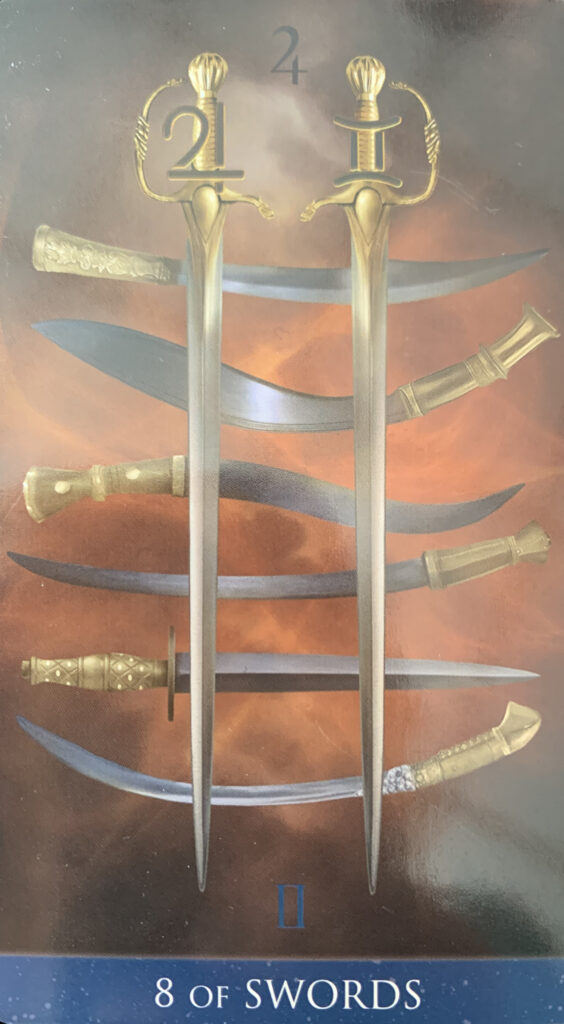
The 8 of Swords
Interpreted by Marv Machura
The Millennium Thoth Tarot
By Renata Lechner
There are two large steel swords pointing downward that have ornate golden hilts. Behind these two beautiful swords are six smaller swords also with fine-looking golden hilts that point horizontally in alternating opposite directions.
These six swords are all different, yet similar. Each sword represents a different culture or nation.
The initial effect of our looking at this arrangement and composition is blockage, difficulty, and fear. There appears to be no possible way through this dangerous arrangement of sharp steel weaponry.
This first response of impasse, trouble, and distress begins to be moderated when we see that none of the swords are directly threatening us. We also see that none of them are in conflict or pointing at each other. In fact, on this second and more‑considered view, we see that this card presents us with an armoury of sharp, deadly, and fantastic swords, ready for our use, rather than for our demise or failure.
As an arsenal of fine, battle‑ready swords, the card still represents a difficult and daunting problem. And this problem is fear.
This card is saying that there is a real adversary out there whom we must defeat and overcome. But this card is also saying that our inner antagonist of fear must first be slain in order for us to go forward and slay that other malicious enemy currently blocking our path and journey.
Thus, the 8 of Swords is not representing an impossible battle ahead from which we need to retreat. Rather, this card is telling us—and encouraging us—to take one or two of these fine steel blades, as a representation of our courage and strength, and use these swords to not only face but also defeat our enemy.
Getting ready for any battle is scary, and it is okay to tremble as we look at this collection of weapons. As such, it is good to recall what Joan of Arc said, “All battles are first won or lost in the mind.”
Yes, it will be frightening to hold one or two of these swords in our hands and be ready to use it. As such, we need to recall (in times such as these) the correct definition of courage: courage is not an absence of fear, but going forward in spite of fear.
There are times when it is best to walk away from conflict, but this is not one of those times. The 8 of Swords is saying to us that we must face and defeat whatever or whoever isthreatening us. This is the only way forward.
The darkness of the background adds to our feelings of unease. But the fiery orange breaking out from the center of this card’s otherwise dark background, represents our intense passion and burning energy that is always there under the surface of our blockage, inaction, and fear.
When we go forward in spite of fear and trepidation, we will release the fury and intensity that is boiling inside of us. And on further deliberation and as part of this release, we will see that this card is assuring us that victory is nearly 100% assured. Recall that fortune nearly always favours the bold.
When we have started seeing this card from this perspective, we apprehend that these eight swords are beautiful, elegant, and expertly crafted. As such, these swords can help us find the mettle, resolve, and valour inside of us rather having these swords contribute to (or cause) our alarm and fright.
The golden hilts are comforting and encouraging. Gold is the colour and substance that most represents durability, attainment, victory, and spiritual wellness and completion.
The symbols for Jupiter and Gemini seen of the golden hilts of the two large vertical swords also work to reinforce the meanings that gold transmits.
The symbol for Jupiter is both the hieroglyph of an eagle and an abbreviation for Zeus. Thus, this symbol is full of the power, strength, and authority associated with the king of birds and the king of the Gods. Jupiter thus represents might, power, and the indominable force of will.
Gemini also represents these attributes but in a different way. In the historic story, the twins, Castor and Pollux, went into a battle in which Castor was killed. Pollux pleaded to Jupiter to restore Castor to life or make them immortal. As a reward for their bravery in battle, Jupiter agreed to the latter. Thus, Castor and Pollux became the constellation of Gemini.
The ancients prayed to these twins for help and courage in battles, and it was a good omen when both stars were shining brightly in the night sky.
The repetition of Jupiter (top center) and Gemini (bottom center), doubles‑down on these aspects incorporated into the 8 of Swords. The placement represents the over‑reaching rule of Jupiter and underlying might of Gemini.
The representation of the two pillars of Solomon’s Temple (Jachin and Boaz) in the symbol for Gemini underlines these meanings as well. Jachin means “He will establish.” Boaz meaning “In Him is strength.” We can imagine that we are passing through these pillars to further bolster our courage and our assurance of victory.
These two pillars (and the meanings associated with them) can also be seen in the two, formidable, double‑edged swords in the forefront of the card. These swords and their symbolic placement are there to give us courage rather than to cause fear.
So in all regards, we can see mighty encouragement coming to us from this card—in direct proportion to our need of this encouragement.
Swords represent our mind, and as such, we understand that this situation is first and foremost in our mind. To wit, we must win the mental battle of overcoming our fear. Then we must move into the fight with the mighty, courageous strength of conviction, power, and confidence.
The number 8 is the number of becoming. It is a reassuring number full of auspicious honours. This should also help to give us the courage we need to become better, move on from inaction, and carry on bravely with our Universal quest.
We are not meant to cower in fear at any time in our journey forward. We must grab hold of the sword that is offered here and step into a much brighter, successful, and happy future.
It is time to remember that our adversary wants to keep us in fear. It is only fear that keeps his bully-like power intact.
Trust the Universe—and even if you are scared to death, as an old saying goes and that can aptly describe our situation—take that deep breath and move forward into the fray. Light and life await in glory on the other side.
June 29, 2022
The 8 of Pentacles
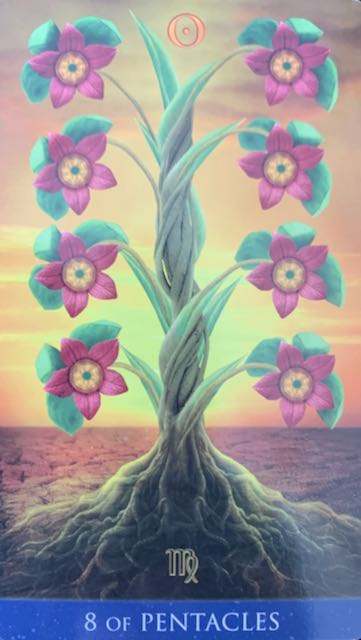
The 8 of Pentacles
The Millennium Thoth Tarot by Renata Lechner
Interpretation by Marv Machura
The imagery on the 8 of Pentacles is dominated by a tough, well-rooted, green plant growing by itself in a flat, arid, desert-like landscape. There are eight, vibrant, red blossoms on this plant arranged in near-perfect symmetry, four on each side of the intriguing, twisting main stock of the plant.
Green is the colour of life, renewal, and peace. Green is often described as a favorite colour due to its association with feelings of wellness, satisfaction, and contentment. This happiness is reinforced by the symmetry of the plant since symmetry also gives us these same feelings. Thus, a central meaning of this card is harmony, rest, and gratification.
The best kind of rest and contentment comes after periods of activity and exertion. And as a rule, the harder or the more robust the exertion, the sweeter the respite and fulfilment. These feelings are doubly amplified when we can clearly see the fruits or results of our work and activity. This is what we perceive in this card. The blossoming plant symbolically represents the goodness, repose, and gladness coming to our life after a time of sustained and strenuous effort and labour.
Importantly, this coming virtuousness is largely the result of our well-directed, stubborn determination. By examining the environment and ground of the card’s imagery, we can see that it was not easy for this strong, healthy, blossoming plant to grow. This arid and seemingly lifeless landscape represents the difficulties that we have overcome. The figure in the image (the plant) represents a contrast to this aridity that is as bold as it is beautiful. The size and positioning of the plant all help to create these pronounced feelings of triumph, strength, and certitude.
The thick base and expansive roots of the plant represent the long, vital period of persistent growth that has been necessary to bring this plant to its current, wonderful blossoming state. The roots are firmly in place, and we can feel the strength that results from this well‑founded connection with the earth.
This imagery also reminds us to stay humble and grateful. Our efforts are never guaranteed to succeed. There are always elements of metaphysics, magic, and chance at play in all of our achievements and victories (as is the case with our tragedies and failures).
Although we have participated meaningfully as may be seen and felt in the roots of this plant, the beautiful blossoms remain as wonders of the force of creation that we can barely comprehend. They are as lucky as lining up 8 stars in a slot machine. With this requisite, humble, and abundant gratitude (as opposed to pride, arrogance, and self‑entitlement), we gain so much more, as always, than is possible without this central aspect of thankfulness in our lives.
The above principle can be, in part, recalled in the wise, old saying: stay grounded. The artist has composed this image so that our gaze will always fall toward this wondrous contact point between the plant and the ground, thus reinforcing these sagacious words.
The golden-orange background warms the scene with gentleness and kindness. Orange is the colour of independence and pride in oneself. With the supplementary golden hues, the colour of worth and value, the scene painted is a panorama of nearly boundless potential. And this bounty is there for us, in spite of the dangers.
The dangers are represented by the tough, unhospitable landscape. But they are also represented by the 8 red blossoms. Although this is not very likely, the blossoms have a potential to charm us into the immobility of intemperance as in an extended and too‑long holiday. We avoid this negative stasis by seeking the horizon. It goes to infinity with a rising or setting sun. Therefore, the message for us is to stay grounded, stay humble, stay thankful—and carry on with our good habits, attitudes, and hope.
There is nothing wrong with celebration as long as it does not lead to what the American Football League (NFL) calls “excessive celebration.” Since 2017, excessive celebration can give your team a 15‑yard penalty in the game. So, enjoy your success, but stay grounded, and stay committed to the contest. There is, after all, plenty of time still on the game clock.
Each red flower blossom has five pedals, thus creating the pentagram shape. With these red flowers as pentacles, they carry all the goodness and blessings of the five‑pointed star. This is the protective and magical power that protects us from curses and hard‑luck. Be assured that the Universe is pleased with our effort and achievement and is handing out charms to protect and encourage us forward.
The symbol for the Sun appears on the top center of the card. This is appropriate since all biological life is sustained with the power of the Sun. Appropriately, we revere the Sun. Its positioning on the card shows how we all look up to the Sun, both literally and metaphorically. This symbol carries meanings of not only life, energy, and growth but also of confidence, clarity, and purpose.
On the bottom center of the card is the symbol for Virgo. Virgo is an earth sign, and thus, it fits with this card’s earthly meanings of material wellness, reward, and harvest. Virgo is linked to both the goddess of justice and the goddess of agriculture (Dike and Persephone, respectively, in Greek mythology). Both of these meanings can be given to this card in the sense that hard work is justly rewarded with a plentiful yield.
The number 8 is the number of abundance as well as reassurance. It is an uplifting number, supporting us to continue forward with confidence and strength. With effort and sustained hope, our dreams can come true. But even more importantly, with effort and sustained hope, work and employment become more of their own reward, as indeed they should be.
The number 8 is not a number of drudgery or slavery. It is a freeing and powerful number that says we are in control, on the right path, and just rewards, continued growth, and elemental goodness are on the way. Contrary to popular belief that the highest goal of life is to reach a stage of ease and contentment as endless vacation days in the sun, this is not true. Rather, we need to be engaged with life and not disengaged from it. We can see this paradox with some famous musicians, like Paul McCartney, who although fabulously rich and at an advanced age, continues to tour, promote, record, and involve himself in his career.
To be disengaged from life in an endless holiday would not be the fairly‑tale perfect life for any of us. Rather, it would be a type of hedonistic hell from which we would likely want to escape after a period of time. Indeed, we often see this in the lives of the privileged classes, or the idle rich, with their falls into the destructive hands of addiction whether that be to drugs, alcohol, sex, or anything else that is accessed as a means of escape from this Hotel California paradise.
In the end, this card is primarily an affirmation of good habits, strong spirit, and a solid connection with the earth. Sure, there are many blessings to be enjoyed and celebrated, but these are of the best kinds of rewards: the kind of rewards that we, ourselves, have had a hand in creating.
Ultimately, our lives are on a step not to that endless hell of holiday, but rather our lives are on a step to the joy of achievement, wisdom, and reflection. Soon enough, the enduring rhythm of struggle, growth, rest, and reward will restart. And if we continue as we are, this course of cycles will keep getting not only easier but also better!
May 24, 2022
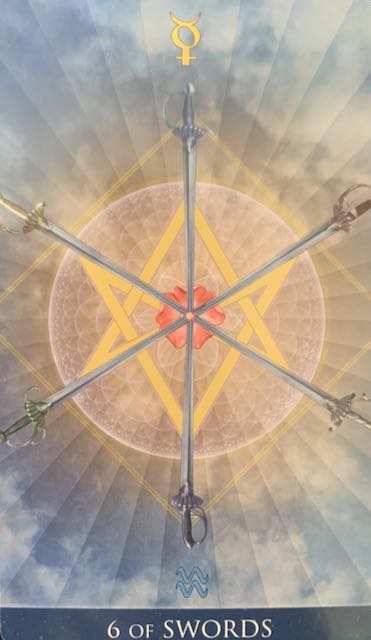
In The Millennium Thoth Tarot Created by Renata Lechner
Interpreted by Marv Machura
The Five-Card Pentagram Tarot
We see six swords coming together in a dramatic pinpoint exactly in the center of this card. The pinpoint where these swords meet and where their sharp points touch is covered by a small red gemstone. This arrangement makes the sword tips appear to be flat or blunted at their ends. The red gem glowing at the center of arrangement is representative of the general meaning of this card: happiness, peace, protection and passion are all on the horizon.
These wonderful things are not only on the horizon, they are also here with force and purpose. This additional meaning comes from the arrangement of the swords that compellingly draws our attention to this red gem. This is an image of how the Universe has collected its energies on these aforenoted aspects of our life. As a result, our mind should feel robust confidence and certitude in our decisions and direction. It is not a time for indecision or deep contemplation of the elemental dichotomy and mystery of life.
This is a time to make a choice and go forward with it; it will change our life for the better. We are ready for it. Not all changes and decisions that we make work out for us. Often this is because we are not ready for the changes or decisions; for example, if we are not ready to change our job or go back to school, the move to a new career or school will likely end in failure. However, the 6 of Swords is a card providing the assurance that we are ready. Success, achievement, and contentment are near and favourable.
Although all six swords are similar, each of their hilts has a slightly different hue. This is symbolic of how there are various shades of meaning and purpose in everything that we do, think, or say. It reminds us that regardless of our certitude, the Universe is never singular or even plural. The Universe, and our fate within it, is always multifaceted and complex and far beyond our puny efforts to understand and know anything with absolute certainty. As Socrates says, “The only true wisdom is knowing you know nothing.”
Under the aim and direction of the six sword points and under the red gem is a pink rose blossom. This is the wild pink rose blossom that is associated with Aphrodite and everlasting love. It is also the rose that Romans used to symbolize secrets that will never be shared. The expression “sub rosa” literally means under the rose. In those times the wild pink rose was placed in meeting areas to ensure secrecy and honesty.
These two meanings are not so far apart, especially with this card. This pink rose represents the eternal and pure intentions that reach into our passions and our intellect in a kind of glorious marriage. This is reminiscent of the marriage between Psyche and Eros (later changed to Cupid in more recent retellings) which is symbolic of the union of heart and mind or passion and reason. This is a time when good and long‑lasting things happen, just like a real marriage when both our heads and hearts are equally combined rather than just one of these two, often opposing elements, are dominate.
In the Greek marriage of Eros and Psyche, the Three Graces spread wild rose petals everywhere and it is said that the Earth was aglow with pink for days in celebration of this union. This rose is also associated with springtime since early spring is when these roses bloom often turning the landscape various shades of this delicate pink reminiscent of this ancient story. This single rose blossom that we see in the center of this card is thus an appropriate symbol of auspicious beginnings as well as balance between our hearts and our heads as we go forward with a fresh and favourable direction.
Surrounding the central point in this card, and in perfect symmetry, are a circle, square, and unicursal hexagram. It is a beautiful rendering of sacred geometry that fits in flawlessly with the six swords presented and positioned where they are.
This symmetry and geometry have long been associated with the perfection and holiness of creation. We humans strive to create and build mimicking the Universe’s divine geometry. As such and as presented on this card, it reinforces the general meaning that our own plans and intentions are in harmony with higher powers of formation and purpose. And this a good thing. When our lives, creations, and buildings stray from the orderly, pleasing, and natural geometry of the Universe, problems result.
The unicursal hexagram is an ancient symbol of humankind’s union with the Universe. It can be drawn without taking our pen off the paper, hence its classification of being unicursal. As such, the action of drawing this shape is spiritual and auspicious. This is like drawing the more common and easier‑to‑draw unicursal five‑pointed pentagram which all children love to draw.
This enjoyment of drawing a unicursal pentagram is not accidental. There is something good and magical in the action of drawing such shapes. Underlying this nearly subconscious pleasure is the creative energy and continuum of time and space. It connects us in a small way to the mostly incomprehensible, incredible, and ever‑lasting continuum in which we live and which has no beginning point and no end point like a unicursal drawing.
Within the large circle are a multitude of spiral patterns showing more complex sacred geometry faintly in the background. This sacred background reinforces the meaning of the foreground and assures us that our most simple actions and words are in fact underpinned by a kind of beautiful complexity that has no beginning or end yet is purposeful and driven towards ever higher order, beauty, and perfection.
Perhaps the modern Muslim faith manifests this aspect of the Universe most completely in their sacred decoration of mosques, but all spiritual leaning and longing indulges in this, as seen also in the Celtic tradition.
The symbol of Mercury appears on the top of this card in eye-catching yellow. Mercury represents communication. Yellow represents honesty, directness, and goodness. Thus, the yellow Mercury is there on top to assure that clear, persuasive thinking and communication will be the order of the day. This reinforces the auspicious spiritual and intellectual changes are forthcoming. And with the addition of the winged messenger Mercury, we can also be assured that these forthcoming changes will be here soon!
At the bottom of this card, and in a gentle blue colour, is the symbol for Pisces. This symbol represents the deep, intuitive subconscious level of vibration that is supporting and underpinning the surface changes. We should be trusting the deep diver of Pisces and attempting to feel its influence on the surface of our lives. When we move with these deep vibrations of truth and certitude, we know that we are doing things that are good and noble even in the smallest of things, but at times like these, this vibration is much more noticeable in the bigger moves and new directions and new projects in which this card is encouraging us forward.
The number 6, itself, is an overall positive number. Sometimes it is there to encourage positive change that is needed, and indeed, this is part of its meaning in this card. But more so, is the number 6’s characteristic meaning of half-way to fulfilment. It is a number that is saying, here you go; you are on the right path; hold your course; good things will come soon, and even better things as you travel onward. Trust your intuition and your selfless service to the greater good.
It is about you, but it is about you and your talents, energies, and work that are chosen for you and their use in a much bigger divine purpose. Do not get selfish; stay humble, stay active, be grateful. Stay in the sacred geometry of your path forward. Embrace your role, your supports, your spiritual sense as the divine child of the Universe that you are!
March 29, 2022
The Prince of Cups Card Interpretation
The Prince of Cups by Renata Lechner: The Millennium Thoth Tarot
Interpreted by Marv Machura

In The Millennium Thoth Tarot Created by Renata Lechner
Interpreted by Marv Machura
The Five-Card Pentagram Tarot
The first thing we notice about this card, The Prince of Cups, is its sense of motion; the Prince, his seashell chariot, his powerful silver eagle are heading straight at the viewer in an unstoppable, dramatic, and confident manner. The noble Prince is looking downward in a humble, yet convincing, sense of both himself and his direction. A swirling, purple dawn surrounds the Prince and this scene of assured movement. Thus, the overall message of this card is clear: we are entering a new and wonderful day or age with strength, divine dignity, purpose, and assistance/encouragement from the Universe. The potential of this new age is immense.
A purple and violet dawn is a somewhat rare occurrence. It is more common for morning skies at dawn to be mostly blue with some orange or red mixed into the wondrous scene, depending on the clouds and atmospheric conditions. Another more common dawn colouring is a deep fiery red that often precedes storms. Most of us are familiar with the saying, red in the morning, sailors take warning. This is because when atmospheric clouds are thickening into storms, this changes the light spectrum from blue to red. But, when atmospheric clouds are thinning as in after a storm, especially serious storms such as hurricanes, the morning light spectrum starts to go back towards blue, causing this purple phenomenon. Thus, a purple dawn tells us that the storms are ending and a beautiful day is beginning.
As the foregoing storms end, the purple dawn represents a new, promising, auspicious, and royal change about to happen, just as a purple dawn predicates a new and beautiful day. In both the card and the weather phenomenon, this colour appears after enduring a stormy period literally for the weather and metaphorically for the Prince. We can also note that these purple and violet hues are colours associated with royal identity and all that goes along with nobility, privilege, and power. These colours are also symbolic of wisdom, bravery, and spirituality. Purple and violet also trigger our sense of wonder, imagination, mystery, and magic. This card, thus, is representative of all of these good, gallant, new, and enchanting things.
The Prince sits in a small, single‑seat, violet chariot that is made from a large seashell. All humans are mystically drawn to and connected to seashells. Children show this innate tendency vividly when on a beach. We see how it is nearly impossible for any of us to not be drawn to seashells because they hold so much positive, healing, and elemental energy. When we see one, we instinctually pick it up, examine, and hold it. Typically, we also will want to keep the shell, usually without considering why.
It is not an accident that seashells are foundational in our conception of value, and why they were used as the first form of money in most human communities around the world. Seashells, like the one in which the Prince sits, give us balance, wealth, protection, energy, and health. They help connect us to life‑giving water as perhaps no other earthy element can or does. It is always good for us to have some seashells in our collections of mystical elements or adornments that assist our metaphysical vibrations. As mentioned, seashells are more than just representative; they are givers and producers of goodness and wellness for our emotional and physical lives.
This strong, nude Prince sits in this magical, purple shell that is giving‑off good energy that we can see swirling around and emanating from the shell‑chariot. On his nude body are tattoos of yellowish wings. His nudity is symbolic of his purity of spirit and purpose. He has nothing to hide. He is coming forward into a new life without shame and without any hidden baggage from his previous adventures. And this nudity shows that his strength is on display in a beautiful and natural manner that others will notice.
Not only is the Prince journeying forward without baggage or shame, he is journeying forward with distinction and decoration. The yellow wing tattoos covering parts of his body represent his earned honours, position, and skills. Granting wings, for example, in the military is an important ceremony that only comes after hard‑won accomplishments and victory.
In his right hand the Prince holds a magnificent white lotus blossom. This large and beautiful white blossom stands out on this card with its size, freshness, and beauty. The Prince holds it by a seemingly living or writhing green stem. All of this reinforces the Prince of Cups purity of spirit and motivation acting in the present and living sense. It also reinforces the restraint of ego pride and id bestiality.
The Prince must beware of these things given his position, power, and strength. Excessive pride and sexual promiscuity are evils that are always near the surface for those so blessed as this Prince. Holding this important symbol in his right or dominant hand shows the importance of controlling these potential evils.
In his left hand, the Prince holds a large blue cup. Inside this cup there is a blue snake. We can see it writhe and stick its head out. The Prince is looking down at this cup and snake. This blue snake has an ambiguous meaning, as is the case with most snakes. On the one hand, it is representative of knowledge and power over ignorance, but on the other hand it is symbolic of dangers, especially deceit and deception.
For this card, both meanings are possible. The Prince must be wary of trickery and duplicity awaiting him in his future. His nobility, strength, and beauty will inevitably draw people to him who will not have his best interests. These will be people who will seek to deceive him with flattery or other means for their own selfish gains and possibly ruin all the goodness inherent to this Prince’s forward progress and purpose. Thus, the Prince must be very careful as he travels onward. This watchfulness of his is clearly illustrated on the card by his concerned downward gaze at the rising snake in this blue cup.
The Prince wears a silver helm that resembles an eagle diving down to make a kill. It fits his head perfectly. This is a battle‑ready helm that not only is used for protection but also as means of intimidation and a sign of high status and knighthood. The ancient meaning of the silver helm is that its wearer is ready to throw himself into battle with full intensity, not caring for his life. The silver helm wearer is committed to higher principles of bravery, glory, self‑sacrifice, and valour. These meanings augment the Prince of Cups as a portent of personal victory through these values and beliefs that are part of the silver helm. It is time to bring these costs and standards to the surface and into the new situation unfolding to assure triumph and success.
Finally, we see a great silver eagle pulling the Prince forward in his seashell chariot. The Prince holds the reins on this eagle loosely in his right hand. There is no need for close control of this eagle. Its entire aspect is full of strength, intensity, and purpose. It flies close to the water showing its control over the sea of emotions below the surface.
The silver eagle is one of the most well‑known and widespread representation of force, allegiance, and bravery. The eagle also represents freedom, hope, and truth. This silver eagle on this card shows all of these things and more. It also illustrates the divine protection and direction that is accompanying the Prince on this journey toward his new situation. There can be no stopping, no pausing, and no turning around. It is time to bring on a new and glorious future.
Marv Machura
March 29, 2022
March 24, 2022
The 8 of Cups Card Interpretation
The 8 of Cups, by Renata Lechner: The Millennium Thoth Tarot
Interpreted by Marv Machura
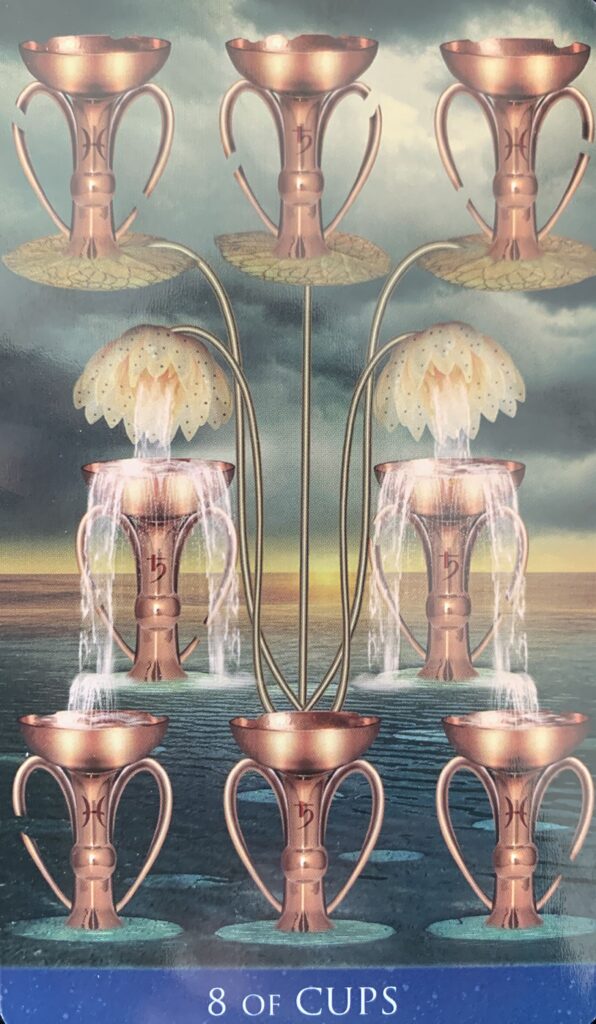
In The Millennium Thoth Tarot Created by Renata Lechner
Interpreted by Marv Machura
The Five-Card Pentagram Tarot
On this card, there are eight bronze cups arranged against a cloudy, somewhat dark, and watery background. The bronze cups are gleaming with various degrees of light, and each one is damaged in some minor way that can be seen when closely examining each one.
Bronze is a metal allow of copper and tin. Bronze is perhaps the oldest alloy in our known, recent human history. After its invention, bronze became such a widely used and durable commodity that this metal alloy became a way to define a long and storied period that we know as The Bronze Age: approximately 4000‑1500 BCE. This age predicates The Iron Age, a time period known for the widespread use of this newer and stronger alloy: iron.
Bronze is a metal of forgiveness and health. It is an unassuming metal: useful, relatively inexpensive, and durable. It is a metal alloy that gives healing vibrations and humility to us when we wear or possess it. Bronze is good metal to have in our kitchens; it is full of the simple and good vibrations that support our fundamental, straightforward needs. For example, in our kitchens, bronze directly enhances the emotional comforts of home and hearth.
The bronze cups pictured on this card represent these unsophisticated and basic aspects of our emotional life that are needing attention. It is time to stop feeling sorry for ourself, forgive others whom we are blaming for our situation, and see that our life, while not filled with golden cups overflowing with the best wine, is essentially okay.
Eight is also the number of transitions; this reinforces the direction provided by this card. As we take responsibility for our happiness, many blessing will be coming our way. There is a reason for our emotional bleakness, and that is, if properly interpreted, to make us more aware of our responsibility for our own emotional wellness. Wehave to forgive. We have to give thanks. We have to smile. And we do not want this any other way. We do not want our happiness to depend on anyone but ourselves.
Each of the eight bronze cups is unique with its own flaws, representing and reminding us of own uniqueness and imperfections. It is our imperfections, after all, that make us humble, kind, and accepting rather than vain, mean, and unyielding. In this way, we can also see how acceptance of our imperfections makes us truly beautiful—and real beauty always comes from within.
Bronze alters and chalices are often used by people to help bring forgiveness, grace, and humility to worship services and communion with the Universe. The cups on this card could all be used as a chalice in such humble and ordinary, yet ironically deeply powerful, experiences. It will assist with the ceremony’s intentional veneration of our life and our spirit. The fact that these cups have heart-shaped handles reinforces this meaning and direct connection to our inner emotional, spiritual, and mental life.
Seven of these cup handles are broken, missing one or two segments, but are still functional. This shows how our hearts get broken, but can still carry on in spite of those missing segments.
We have to accept that life is like this. As we journey forward, pieces of our heart will be taken away, but our hearts will still be capable of loving as well as keeping us alive, pumping both blood and life force. Thus, we can see our human hearts reflected in these bronze handles which, although broken, are still useable and still beautiful in spite of the damages and missing, broken bits.
One bronze cup in the center of the bottom row is complete, with no missing segments. From behind this perfect cup, five bronze pipes rise upward. Two of these pipes appear to be pumping water into a couple of white lotus flowers above the two cups in the middle row. These lily blossoms are showering life‑giving water into these two cups, and the two cups are overflowing with sparkling water.
Notice how abundant water is filling the two cups on the outer sides of the bottom row? This reaffirms the imperative message of this card that all is not lost. Hope and happiness can be found even in times of trouble and emotional vacancy. We can move forward being more mature, more stable, more humble, and more resilient, just like bronze itself, once we stop feeling sorry for ourselves, count our blessings, and take personal control of our emotional lives.
The two white lotus blossoms gleam and glow with light. The white lotus flower has extensive symbolic meanings and associations. The most common of these symbolic associations are mental and spiritual purity, grace, and perfection. The white lotus is also representative of control over and pacification of the meaner or angrier parts of our nature. The white lotus has the power to restore us to a more whole and happy state when our emotional lives are being clouded by the darkness of self-pity, resentment, emptiness, and negativity.
We can also see this theme of resetting our emotional view of life to being kinder, less dark, and wholesome in the background imagery in this card. At first glance, this background appears dark, stormy, and cloudy. But on second glace, we see that light is breaking through the clouds and golden sun is glowing on the horizon. When our new, and sunnier, view looks again at the bronze cups, we see that they are shining rather than being dull and grey. This reminds us of the old adage that we do not see the world the way the world is; we see the world the way we are.
Three bronze pipes also rise from this bottom central cup as if to directly feed/water the green lily pads on which the empty, cups sit in the top row of cups. Lily pads are able to grow in the most foul and muddy water and as such, lily pads represent resilience, rebirth, and resurrection.
In nature, these plants act as water purifiers to the ecosystem and build, maintain habitat for many species, providing food, shelter, and beauty in otherwise bleak and lifeless environments. These humble lily pads pictured on this card, while somewhat damaged and dry, are still green and alive, ready to continue to grow and reproduce when the dark times pass, and the sun returns to amplify their metabolism.
Four of the bronze cups have the engraved symbol of Pisces and the other four are imprinted with Saturn. Pisces is the symbol of inner and individual spirituality; this reinforces the message in the 8 of Cups: go inward into our own heart to search for meaning and happiness. Pisces people are not the type to blindly worship or follow anything or anyone. They are independent seekers of truth. They are rightly skeptical of anyone claiming to have the answers. Although they may seem arrogant and unyielding, they are really just deep‑divers into the bottomless waters of our humanity.
It is appropriate that the Pisces symbols are on the outside cups, seeming to contain or frame the cups with Saturn’s symbol since Saturn is associated with stubbornness and obstinacy. This arrangement suggests a balance between Saturn’s strength of conviction and Pisces deeply‑seated mystery. Together these two forces are able to look inward, solve problems, and carry on with the necessary certainty, strength, and will power to keep our inner self and emotional life in our own firm control—and not in the control of anything or anyone else.
The number 8 is also representative of inner stability and equilibrium. This number is saying that we need to clear our minds and hearts of unnecessary and harmful elements before we can advance as the spiritual beings that we are.
We also need to take direct, personal responsibly for our feelings and emotions that can and will bog down our spiritual journey toward Heaven. This number 8 reminds us that this type of personal awareness and responsibly is one of the first required steps in discovering and enhancing our dynamic spiritual growth. Finally, this number may remind us that our spiritual growth and increasing maturity is a major part of and reason for our lives on this planet.
The 8 of Cups is here to assure us that our lives will soon be full of confidence, strength, and spiritual enlightenment. This card reminds us that there is no possible growth without struggle. And this struggle to be master of our own inner life is one of the most fundamental and vital struggles we face on our way to higher and happier ground.
March 21, 2022
The Tower Card Interpretation
The Tower, by Renata Lechner: The Millennium Thoth Tarot
Interpretation by Marv Machura
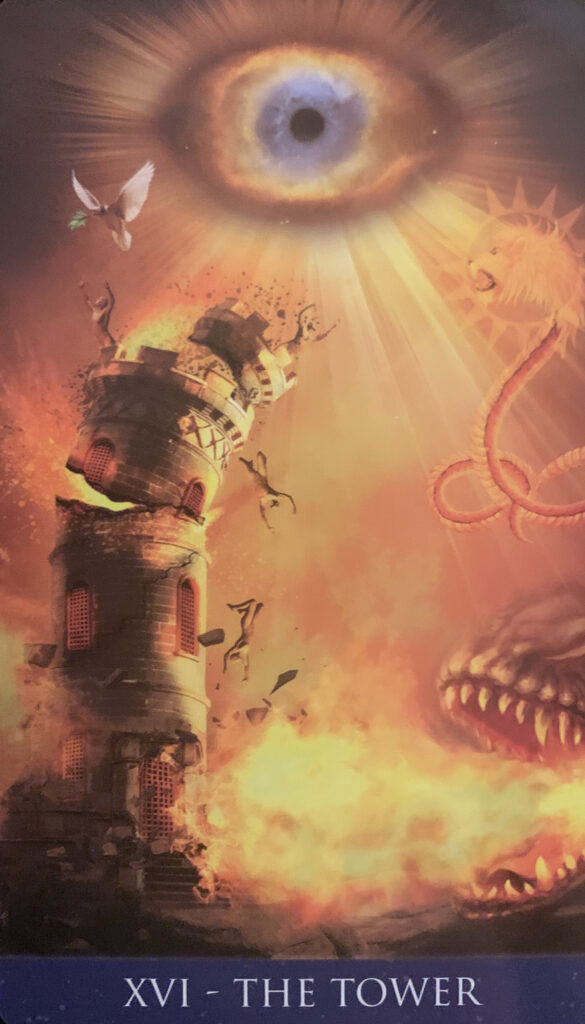
XVI The Tower
Dominating this card is the all‑seeing eye: large, luminous, and inscrutable. It is firmly placed at the top of the card in a dark sky. The all‑seeing eye dwarfs and overshadows the demolished tower and humans in the scene of devastation below. As a representation of the supreme power of the Universe, the message is clear. There is nothing we can do in times such as these. Our freedom and power have limits; the Universe is always in firm control of everything.
If our pride or hubris is such that we think otherwise, this card is here to remind us of how puny and pathetic we really are. It is always better to be humble, accepting, and cognizant in all of our actions, creations, and deeds that the Universe has infinitely more power than we can ever—and should never—assume for ourselves.
We have to trust the Universe even in times of complete and total destruction that the all‑seeing eye is watching and knows what is best, even when we are metaphorically or literally thrown from our towers of security, home, career, and even our temporal life. The over‑riding lesson of humility in the story of the Tower of Babel and as is visually referenced and represented in this card must be heeded. We are not gods, and we should never act as if we were.
This card is, as well, representative of the ancient wisdom contained in many sacred books and as written in the Biblical Proverbs, “Pride comes before destruction, and a haughty spirit before a fall” (16:8). The Universe reserves the most intense transformation through sudden and complete burning, destruction, consumption for those times when we, as individuals, and we, as cultures or nations, not only forget our place in the divine and physical world but also seek to replace the supreme entity with our short, mortal lives, our machines, our technology, etc. When we do this replacement, it is not only a great mistake but also a great affront to the Universe that gave us life, freewill, and those gifts which we should be grateful for rather than prideful of.
The eye represents a part of the divine force of Shiva, the Indian supreme being of transformation, creation, destruction. Lord Shiva is the deity of both death and time. Shiva comprises those aspects of Yahweh (Hebrew) of the Old Testament: fearsome, protective, and all‑powerful. We can see how this representation of the all‑seeing eye on this card has this primal force of both benevolence and fear. It is painted such that the all‑seeing eye looks directly into our spirit. If our spirit is full of pride and sin, we want to run and hide, but if our spirit is pure and humble, we want to bow down in veneration and reverence.
The eye is blue. This blue iris surrounding the dark pupil suggests wisdom, faith, and trust. These are aspects of the all‑seeing eye that balance its more fearsome qualities and reinforce the over‑riding assurance that accompanies The Tower in the Tarot. There are times when we must trust what we may not understand, especially in the dark times of death and destruction where our faith can metaphorically fall, just like real tower pictured in the image.
Orange and yellow fiery light shines from the all‑seeing eye’s grandeur. This glorious light is the fire of divinity as in the ever‑burning alter, the burning bush of Moses, and the fiery finger that carved the Ten Commandments on the stone tablets as well as many other representations of the creative, destructive, and divine power of the Universe. In all these examples, as in this card’s imagery, we are right to be fearful, but we should also be in amazement, reverence, and awe. It is in times of tremendous transformations, such as these, that we have to leave behind the old and welcome in the new and better world that is promised and inherent in this spiritual and physical fire. As in the story of Sodom and Gomorrah (Genesis 19), we must not look back on the destruction of the old. Let it crumble and burn. Trust the Universe. Do not even turn around; this will assure that you will carry on and not go down with the tower.
Dominating the bottom right of this card is a fearsome, fire‑breathing beast blasting the tower from below. Its fire is as intense as an incinerator, and this contrasts with the holy fire coming from the Heavens above. This reminds us of the earthly nature of change and transformation. Just because our Earthly towers burn, break, and tumble, does not mean that same is true in the Heavens. This earthly destruction is temporal and necessary.
The grim visual imagery of this sharp‑toothed, wide‑gaping, and fiery‑mouthed beast reminds us of our powerlessness in times such as these. The destruction is rapid, complete, and painful. It is futile, vain, and pointless to stand in its way.
This fearsome mouth also represents the Hebrew letter Pe`. This letter is a reminder of the importance and holy nature of speech. Words have the power to cast spells of great goodness as well as great evil. The childhood notion of “sticks and stones may break my bones, but names will never hurt me” is only a victim’s somewhat effective healing spell. As we know, words and names used by the aggressor, bully, or anyone using them to destroy, hurt, and obliterate another are as powerful as the flames of Hell itself—and as represented in this card coming from the mouth of this beast.
A lone dove with an olive branch in its mouth hoovers, hanging in the sky above the falling tower. This dove alludes directly to the story of Noah and the Ark. Noah’s dove left the ark while it was still adrift with no land in sight; it returned later with an olive branch in its mouth. This was a sign that the great flood was receding and soon to be over. This dove also represents the peace and life to follow after the unreserved and widespread destruction of the present.
The olive branch represents forgiveness, peace, and general goodness. It is just a small speck of green in an otherwise completely apoplectic scene, but this green stands out beautifully on this card reminding us of that life will be reborn and carry on. It will be purified, peaceful, and cleansed of whatever needed to be destroyed in order to let this new life grow.
A large snake with a lion’s head swirls and floats above the beast’s head on the right side of this card. This is the ancient Chnoubis. The Chnoubis is the Egyptian and Gnostic solar icon found most often on gems and amulets used for protection against poison and disease. This Chnoubis on this card has a halo of 12 points representing the 12 signs of the Zodiac and the sacred circle of life in which we all live. This symbol is here to protect us through the destruction that must occur. It also is representative and a reminder to us of the eternal progression of life, death, and rebirth.
The Chnoubis is also associated with wisdom and rule. With its snake’s body and lion’s head it represents the connection between Heaven and Earth in fertility and order out of chaos. It stands up proud, fierce, and strong giving us the exact amount of courage and wisdom that we need to get through this time of dramatic, catastrophic, and far-reaching transformation.

